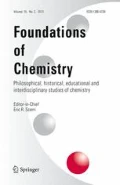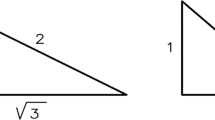Abstract
While temporal considerations are of prime importance for chemical reactions, as well as for molecular stability, most chemical concepts (outside of the field of chemical kinetics) are not explicitly formulated on a diachronic basis (Earley in Found Chem 14:235, 2012). It will be argued here that a formulation explicitly incorporating temporal and epistemological considerations enables us to treat chemical reactions and chemical substances on ontologically equivalent terms, instead of assigning a more fundamental status to the latter. After all, in collision theory, a chemical substance is just a collision complex (a “resonance”) that takes too long. How long qualifies as “too long”, and “too long” in relation to what, are crucial questions that distinguish chemical substances from chemical reactions, and reversible reactions from irreversible ones, thereby introducing anthropocentric considerations into these distinctions. Too long for a lab chemist is very different from too long for an astrochemist studying chemical reactions between chemical substances in inter-stellar space on cosmological timescales. Examining several physical and chemical properties on the basis of which chemical substances are distinguished from one another, the role of temporal and anthropocentric considerations in defining molecular properties is emphasized. I conclude with some observations on the much-debated reduction of chemistry to other disciplines, arguing that such reduction depends on our aesthetic choices as to what kinds of observations demand explanation, and what kinds of explanation are acceptable.

adapted from Sato (1955a)
Similar content being viewed by others
References
Ballard, J.G.: Myths of the Near Future. Triad-Panther, London (1984)
Bars, I.: Two-Time Physics (2000). https://arxiv.org/abs/hep-th/0008164
Bars, I., Deliduman, C., Minic, D.: Phys. Rev. D 59, 125004 (1999)
Craig, W., Weinstein, S.: On determinism and well-posedness in multiple time dimensions. Proc. R. Soc. A 465(2110), 3023–3046 (2008)
De Witt, B.S.: Quantum mechanics and reality. Phys. Today 23(9), 30 (1970). https://doi.org/10.1063/1.3022331
Earley, J.E.: Process structural realism, instance ontology and societal order. In: Riffert, F., Sander, H.-J. (eds.) Whitehead's Process Philosophy: System and Adventure in Interdisciplinary Research. Discovering New Pathways, pp. 190–211. Alber, Berlin (2008)
Earley, J.E.: A neglected aspect of the puzzle of chemical structure: how history helps. Found. Chem. 14, 235 (2012)
Earley, J.E.: In: Scerri, E., & Fisher, G. (eds.) Essays in Philosophy of Chemistry, pp. 199–216. Oxford University Press (2016)
Eddington, A.S.: The Nature of the Physical World. Cambridge University Press, Cambridge (1928)
Eddington, A.S.: The Philosophy of Physical Science. Macmillan, New York (1939)
Einstein, A.: Zur Elektrodynamik bewegter Körper. Ann. Phys. 17(10), 891–921 (1905a)
Einstein, A.: Ist die Trägheit eines Körpers von seinem Energieinhalt abhängig? Ann. Phys. 18(13), 639–641 (1905b)
Einstein, A., Podolsky, B., Rosen, N.: Can quantum-mechanical description of physical reality be considered complete? Phys. Rev. 47, 777 (1935)
Everett, H.: Relative-state formulation of quantum mechanics. Rev. Mod. Phys. 29, 454–462 (1957)
Eyring, H., Lin, S. H.: In: Eyring, H., Henderson, D., Jost, W. (eds.) Physical Chemistry an Advanced Treatise, vol. VI-A. Academic Press, New York (1974)
Goethe's Theory of Colours, 1810: Translated from the German; with Notes by Charles Lock Eastlake, R.A., F.R.S. John Murray. London (1840 )
Hawking, S.: A Brief History of Time. Bantam Books, London, UK (1988)
Hoffmann, B.: Albert Einstein Creator and Rebel. New American Lib, New York (1972)
Hoyle, F., Hoyle, G.: Fifth Planet. Heinemann, London (1963)
Hoyle, F.: October the First is Too Late. Fawcett-Crest, Greenwich (1966)
Hoyle, F., Narlikar, J.V.: Action at a Distance in Physics and Cosmology. Freeman, San Francisco (1974)
Jaffe, A.: The illusion of time. Nature 556, 304–305 (2018)
Johnson, P.M.: The multiphoton ionization spectrum of Benzene. J. Chem. Phys. 64(10), 4143–4148 (1976)
Jordan, G., Deeb, S.S., Bosten, J.M., Mollon, J.D.: The dimensionality of color vision in carriers of anomalous trichromacy. J. Vision 10(8), 12 (2010)
Juarrero, A.: Dynamics in Action: Intentional Behavior as a Complex System. MIT Press, Cambridge, MA (1999)
Keserű, G.M., Soós, T., Kappe, C.O.: Anthropogenic reaction parameters – the missing link between chemical intuition and the available chemical space. Chem. Soc. Rev. 43, 5387 (2014)
Leal, W., Restrepo, G.: Formal structure of periodic system of elements. Proc. Roy. Soc. A. 0581 (2018).
London, F.: Quantenmechanische Deutung des Vorgangs der Aktivierung. Z. Electrochem. 35, 552 (1929)
Martínez-González, J.C., Fortin, S., Lombardi, O.: Why molecular structure cannot be strictly reduced to quantum mechanics. Found. Chem. 21, 31–45 (2019)
Paetz, T.-T.: An Analysis of the ‘Thermal-TimeConcept’ of Connes and Rovelli, Diplomarbeit, Georg-August-Universität Göttingen (2010)
Penrose, R.: The Emperor’s New Mind. Oxford University Press, Oxford (1989)
Petkov, V. (ed.): Relativity and the Dimensionality of the World. Springer, Berlin (2007)
Polanyi, J.C., Schreiber, J.L.: Distribution of reaction products (theory). Investigation of an ab initio energy-surface for F + H2 → HF + H. Chem. Phys. Lett. 29, 319 (1974)
Polanyi, J.C., Schreiber, J.L.: The reaction of F + H2 → HF + H. A case study in reaction dynamics. Faraday Discuss. Chem. Soc. 62, 267 (1977)
Popper, K.: The Logic of Scientific Discovery. Routledge, Abingdon-on-Thames (1959)
Porter, R.N., Karplus, M.: Potential Energy Surface for H3. J. Chem. Phys. 40, 1105 (1964)
Porter, R.N., Stevens, R.M., Karplus, M.: Symmetric H3: a Semiempirical and Ab Initio Study of a Simple Jahn-Teller System. J. Chem. Phys. 49, 5163 (1968)
Restrepo, G.: Building classes of similar chemical elements from binary compounds and their stoichiometries. In: Benvenuto, M.A., Williamson, T. (eds.) Elements Old and New: Discoveries, Developments, Challenges, and Environmental Implications, ACS Symp. Ser. vol. 1263, chap. 5, pp. 95–110. American Chemical Society, Washington, DC (2017)
Restrepo, G., Villaveces, J.L.: Mathematical thinking in chemistry. HYLE (Int. J. Phil. Chem.) 18(1), 3–22 (2012)
Rovelli, C.: The Order of Time. Penguin, London, UK (2018)
Sato, S.: A new method of drawing the potential energy surface. Bull. Chem. Soc. Jpn. 28(7), 450–453 (1955a)
Sato, S.: On a new method of drawing the potential energy surface. J. Chem. Phys. 23(3), 592–593 (1955b)
Schuster, M.M.: Is the flow of time subjective? Rev. Metaphys. 39(4), 695–714 (1986)
Varandas, A.J.C.: A LEPS potential for H3 from force field data. J. Chem. Phys. 70, 3786 (1979)
Velev, M.: Relativistic mechanics in multiple time dimensions. Phys. Essays 25(3), 403–438 (2012). https://doi.org/10.4006/0836-1398-25.3.403
Vogel, A.I.: Textbook of Macro and Semimicro Qualitative Inorganic Analysis. Prentice Hall Press, London (1968)
Wesson, P.: Time as an Illusion. In: Petkov, V. (ed.) Minkowski Spacetime: A Hundred Years Later. Fundamental Theories of Physics, vol. 165. Springer, Dordrecht (2010)
Acknowledgements
The author acknowledges fruitful discussions with Professors Joseph E. Earley, Sr., Guillermo Restrepo and Eugen Schwarz, and support from the Science & Engineering Board (SERB) India under grant EMR2016-002141. Several helpful suggestions from the referees are also gratefully acnowledged.
Author information
Authors and Affiliations
Corresponding author
Additional information
Publisher's Note
Springer Nature remains neutral with regard to jurisdictional claims in published maps and institutional affiliations.
Rights and permissions
About this article
Cite this article
Sukumar, N. Ontological status of time in chemistry. Found Chem 22, 353–361 (2020). https://doi.org/10.1007/s10698-020-09370-8
Published:
Issue Date:
DOI: https://doi.org/10.1007/s10698-020-09370-8




